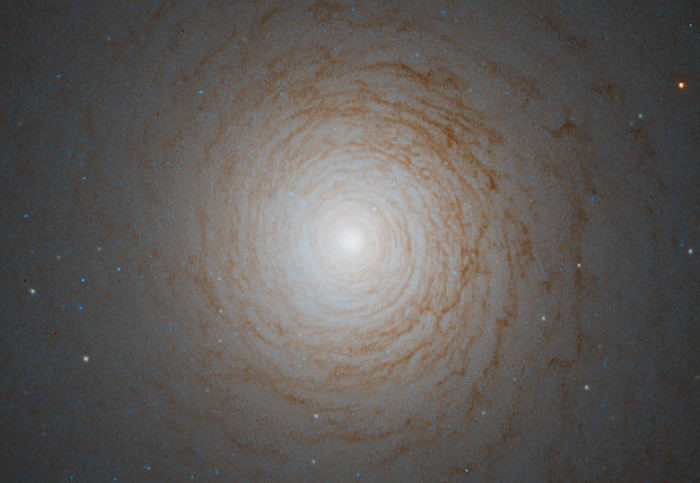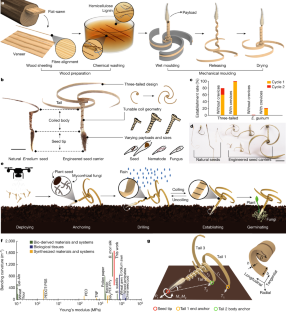- 銀河の中心にある超巨大ブラックホールの観測から、宇宙の70%を占める「失われた」暗黒エネルギーが存在する可能性が指摘されています。 Observations of supermassive black holes at the centres of galaxies point to a likely source of dark energy – the ‘missing’ 70% of the Universe.
銀河の中心にある超巨大ブラックホールの観測から、宇宙の70%を占める「失われた」暗黒エネルギーが存在する可能性が指摘されています。 Observations of supermassive black holes at the centres of galaxies point to a likely source of dark energy – the ‘missing’ 70% of the Universe.
2023-02-15 インペリアル・カレッジ・ロンドン(ICL)

One of the galaxies studied, NGC524. Credit: ESA/Hubble
◆古代の銀河や休眠銀河から得られた測定結果は、アインシュタインの重力理論で予言された現象と一致し、ブラックホールが予想以上に成長していることを示しました。この結果は、ダークエネルギーを説明するために、私たちの宇宙観に新しいものを加える必要がないことを意味します。つまり、ブラックホールとアインシュタインの重力が組み合わさったものが、ダークエネルギーの源なのです。
◆この結論は、ハワイ大学を中心に、インペリアル・カレッジ・ロンドンやSTFC RALスペースの物理学者を含む9カ国17名の研究チームによって得られました。この研究成果は、アストロフィジカル・ジャーナル誌とアストロフィジカル・ジャーナル・レターズ誌の2つの論文に掲載されています。
◆1990年代、宇宙の膨張が加速していることが発見されました。つまり、すべてのものが他のものからどんどん遠ざかっているのです。これは説明しがたいことです。宇宙に存在するすべての物体の間に働く重力が、膨張を遅らせているはずなのです。
◆これを説明するために、「暗黒エネルギー」が重力よりも強く物事を押し広げているという説が提唱されました。これは、アインシュタインが提唱し、後に破棄された「宇宙定数」という概念と関連している。宇宙定数は重力に対抗し、宇宙の崩壊を防いでいるのだ。
◆この概念は、宇宙の加速度的膨張が発見されたことで復活し、その主成分は、時空そのものに含まれる一種のエネルギー、「真空エネルギー」と呼ばれるものであることが判明した。このエネルギーが宇宙を押し広げ、膨張を加速しているのだ。しかし、ブラックホールには問題がありました。ブラックホールには非常に強い重力があり、特にその中心部では、すべてが壊れてしまうような「特異点」と呼ばれる現象が発生し、それに対抗することが難しいのです。
◆この新しい結果は、ブラックホールが真空エネルギーを含んでいることと矛盾しない方法で質量を増加させ、ダークエネルギーの供給源となり、ブラックホールの中心に特異点が形成される必要性をなくしたことを示しています。
◆この結論は、90億年にわたるブラックホールの進化を研究することによって得られた。ブラックホールは、大質量の星がその一生を終えるときに形成される。銀河の中心にあるものは、超巨大ブラックホールと呼ばれます。比較的狭い空間に太陽の数百万〜数十億倍の質量を持つ星が存在し、非常に強い重力がかかっています。
◆ブラックホールは、近づきすぎた星を飲み込んだり、他のブラックホールと合体したりして物質を取り込み、大きくなることがあります。研究チームは、これらの効果だけで超巨大ブラックホールの成長を説明できるかどうかを調べるために、90億年にわたるデータを調べました。
◆研究チームは、宇宙の初期に進化した後、休眠状態にある巨大楕円銀河と呼ばれる特殊な銀河に注目しました。休眠銀河は星の形成が終わり、中心にあるブラックホールに蓄積される物質がほとんどないため、これ以上の成長は通常の天体物理学的過程では説明できないことになります。
◆遠方銀河(若い頃)と局所楕円銀河(老いて死んでいる)の観測結果を比較すると、降着や合体で予測されるよりもはるかに大きく成長していることがわかります。
◆さらに、宇宙の進化の異なる時期にある銀河の集団を使って測定を行ったところ、宇宙の大きさとブラックホールの質量がよく一致することがわかりました。これは、宇宙で観測された暗黒エネルギーが、ブラックホールの真空エネルギーで説明できることを示しています。
◆これは、ブラックホールが実際に真空エネルギーを含んでおり、宇宙の膨張と「結合」して、宇宙の膨張に伴って質量が増加していることを示す初めての観測的証拠であり、「宇宙結合」と呼ばれる現象である。今後の観測で確認されれば、宇宙結合は、ブラックホールとは何かという我々の理解を再定義することになるでしょう。
◆研究の筆頭著者であるハワイ大学天文学者、ダンカン・ファラーは、インペリアル大学の元博士課程の学生であり、次のように語っています。「私達は、同時に2つのことを言っています。典型的なブラックホール解決策が、長い長い時間スケールでうまくいかない証拠があることと、ダークエネルギーの天体物理学的な供給源を初めて提案したことです。
◆「アインシュタインの重力理論におけるブラックホールこそがダークエネルギーなのです。
<関連情報>
- https://www.imperial.ac.uk/news/243114/scientists-find-first-evidence-that-black/
- https://iopscience.iop.org/article/10.3847/1538-4357/acac2e
- https://iopscience.iop.org/article/10.3847/2041-8213/acb704
z ≲ 2の楕円銀河における超巨大ブラックホールの優先的な成長チャンネル A Preferential Growth Channel for Supermassive Black Holes in Elliptical Galaxies at z ≲ 2
Duncan, Sara Petty, Kevin S. Croker, Gregory Tarlé, Michael Zevin, Evanthia Hatziminaoglou, Francesco Shankar, Lingyu Wang, David L Clements, Andreas Efstathiou, Mark Lacy, Kurtis A. Nishimura, Jose Afonso, Chris Pearson and Lura K Pitchford
The Astrophysical Journal Published 2023 February 2
DOI:10.3847/1538-4357/acac2e

Abstract
The assembly of stellar and supermassive black hole (SMBH) mass in elliptical galaxies since z ∼ 1 can help to diagnose the origins of locally observed correlations between SMBH mass and stellar mass. We therefore construct three samples of elliptical galaxies, one at z ∼ 0 and two at 0.7 ≲ z ≲ 2.5, and quantify their relative positions in the MBH−M* plane. Using a Bayesian analysis framework, we find evidence for translational offsets in both stellar mass and SMBH mass between the local sample and both higher-redshift samples. The offsets in stellar mass are small, and consistent with measurement bias, but the offsets in SMBH mass are much larger, reaching a factor of 7 between z ∼ 1 and z ∼ 0. The magnitude of the SMBH offset may also depend on redshift, reaching a factor of ∼20 at z ∼ 2. The result is robust against variation in the high- and low-redshift samples and changes in the analysis approach. The magnitude and redshift evolution of the offset are challenging to explain in terms of selection and measurement biases. We conclude that either there is a physical mechanism that preferentially grows SMBHs in elliptical galaxies at z ≲ 2, or that selection and measurement biases are both underestimated, and depend on redshift.
ブラックホールの宇宙論的結合の観測的証拠と天体的な暗黒エネルギー源へのインプリケーション Observational Evidence for Cosmological Coupling of Black Holes and its Implications for an Astrophysical Source of Dark Energy
Duncan, Kevin S. Croker, Michael Zevin, Gregory Tarlé, Valerio Faraoni, Sara Petty, Jose Afonso, Nicolas Fernandez, Kurtis A. Nishimura, Chris Pearson, Lingyu Wang, David L Clements, Andreas Efstathiou, Evanthia Hatziminaoglou, Mark Lacy, Conor McPartland, Lura K Pitchford, Nobuyuki Sakai and Joel Weiner
The Astrophysical Journal Letters Published 2023 February 15
DOI:10.3847/2041-8213/acb704

Abstract
Observations have found black holes spanning 10 orders of magnitude in mass across most of cosmic history. The Kerr black hole solution is, however, provisional as its behavior at infinity is incompatible with an expanding universe. Black hole models with realistic behavior at infinity predict that the gravitating mass of a black hole can increase with the expansion of the universe independently of accretion or mergers, in a manner that depends on the black hole’s interior solution. We test this prediction by considering the growth of supermassive black holes in elliptical galaxies over 0 < z ≲ 2.5. We find evidence for cosmologically coupled mass growth among these black holes, with zero cosmological coupling excluded at 99.98% confidence. The redshift dependence of the mass growth implies that, at z ≲ 7, black holes contribute an effectively constant cosmological energy density to Friedmann’s equations. The continuity equation then requires that black holes contribute cosmologically as vacuum energy. We further show that black hole production from the cosmic star formation history gives the value of ΩΛ measured by Planck while being consistent with constraints from massive compact halo objects. We thus propose that stellar remnant black holes are the astrophysical origin of dark energy, explaining the onset of accelerating expansion at z ∼ 0.7.



